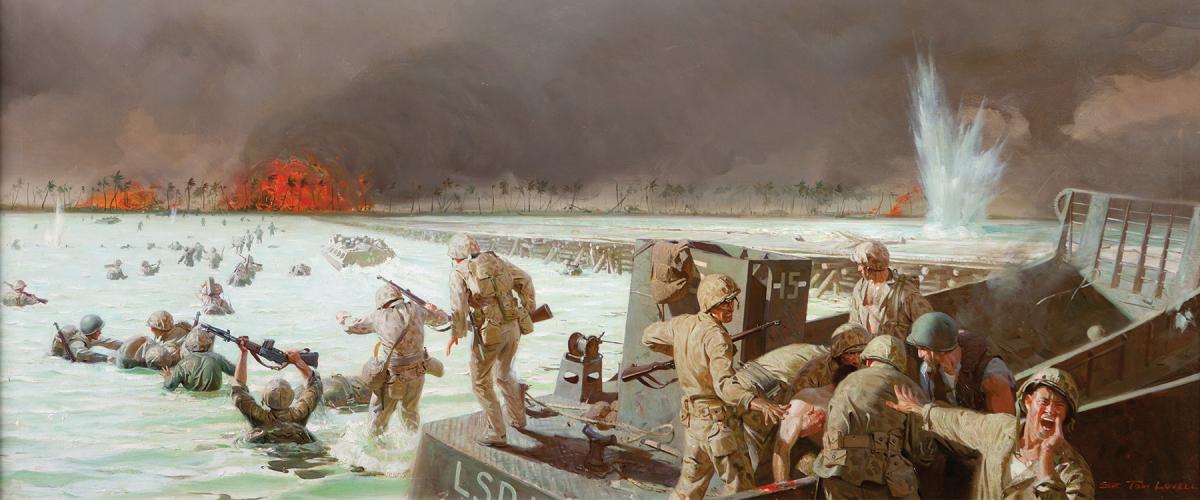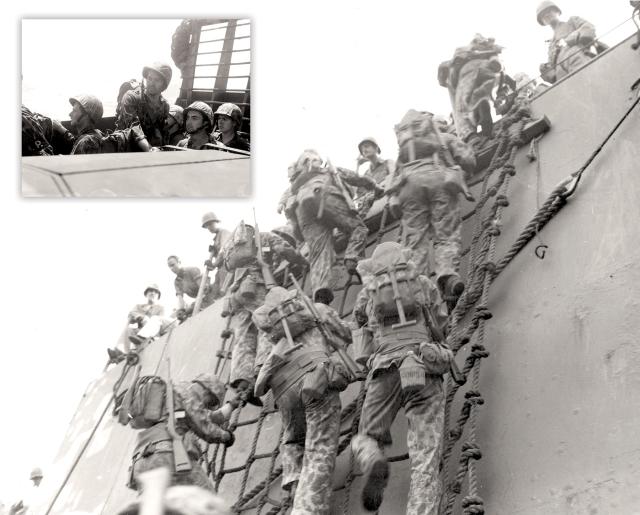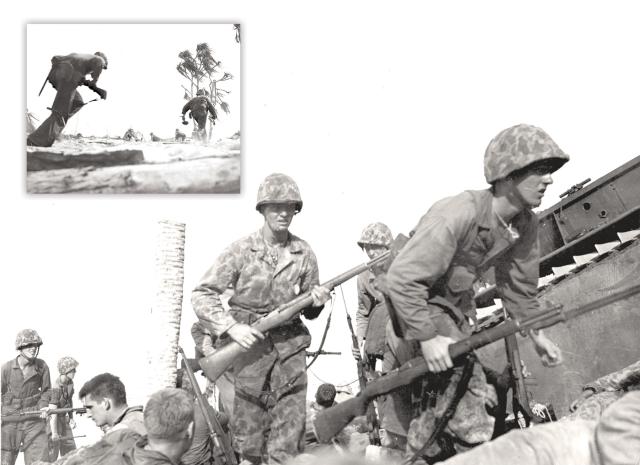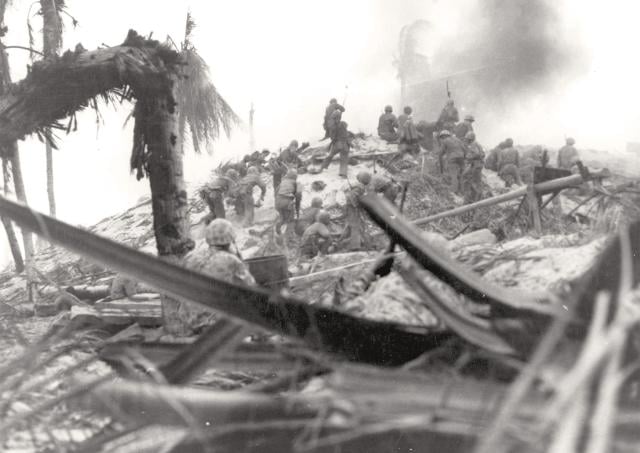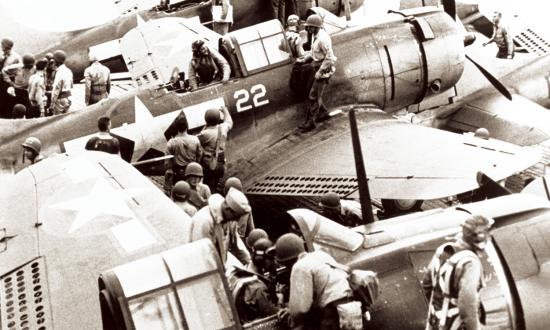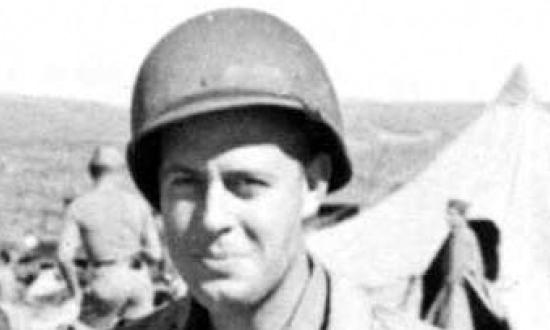From the Aleutians, down through the Marshall Islands, through the Gilbert Islands, and on to the Bismarck Archipelago, there stretched a formidable line of Japanese defenses in 1943. They provided fixed-base garrisons to stall American naval maneuver long enough for air, surface, and submarine counterstrokes from Truk or the Bismarcks. And in the Gilberts, along an outer barrier of these defenses, there stood Tarawa Atoll.
Rear Admiral Keiji Shibasaki commanded Tarawa’s Third Special Base Force. Defenders were spread throughout the atoll; at the core were the Sixth Yokosuka Special Landing Force and the Seventh Sasebo Special Landing Force. Korean construction troops from the 111th Construction Unit and Fourth Fleet Construction Department Detachment, under Rear Admiral Tomonari Saichiro built an airfield and substantial defenses on Betio—the largest island in the atoll. Concrete, coral, and coconut logs all contributed to defenses at the shoreline and within the limited depth the island provided. Shibasaki felt, with some justification, that the position could not be taken in “a hundred years.”
A Tough Nut to Crack
Betio was 3,800 yards long and 800 yards across at the widest, narrowing down to 50 yards, with no more than 10 feet of elevation and less than 300 acres—one third the size to New York City’s Central Park. The island was surrounded by a flat, shallow reef that reached some 550 yards seaward. Within the limits of time, terrain, and material, the island was fortified with strong points and barriers. Coast artillery came with guns ranging from 80mm through 200mm; antiaircraft artillery provided dual-purpose weapons from 13mm to 37mm; light tanks and numerous infantry-support weapons gave the island firepower in depth.
Some 3,000 contact mines were installed, along with barbed wire, concrete anti-boat obstacles, and anti-tank ditches that prevented quick or easy movement on the shallow beach or farther inland. The airstrip divided the island into northern and southern halves. A number of concrete structures for command-and-control existed for protection rather than for fighting. There was a lack of freshwater sources, and another weakness existed in the dependence on exposed telephone wires or messengers for communications.
The U.S. Joint Chiefs of Staff directed Pacific Fleet and Ocean Area commander Admiral Chester W. Nimitz to invade the Gilbert Islands by 1 Deember 1943. The Fifth Fleet, under the command of Vice Admiral Raymond A. Spruance in the USS Indianapolis (CA-35), would fulfill this objective. Its execution fell to the Fifth Fleet’s Fifth Amphibious Force, commanded by Rear Admiral Richmond Kelly Turner in the USS Pennsylvania (BB-38).
In naval terms, this was the largest invasion fleet yet assembled for a landing: 17 aircraft carriers of all types, 12 battleships, 12 cruisers, 66 destroyers, and some 36 troop transports. Turner divided his command into the Northern and Southern Attack Forces, Task Force 52 (TF-52) and Task Force 53 (TF-53) respectively. Along with the naval forces was the U.S. Army’s 27th Infantry Division—and the U.S. Marine Corps’ V Amphibious Corps, commanded by Major General Holland M. Smith.
The Southern Attack Force of Vice Admiral Harry W. Hill was on board the USS Maryland (BB-46), along with the landing force commander, Marine Corps Major General Julian C. Smith. TF-52 and TF-53 would undertake Operation Galvanic: capturing, respectively, Makin and Tarawa Islands in the Gilberts, protecting lines of communication to Australia, New Zealand, Samoa, and Fiji. More importantly, the operation would allow needed basing to move forward to the Marshalls and beyond.
Sailing from Wellington, New Zealand, on 1 November, TF-53 assembled and conducted rehearsals at Efate, New Hebrides. Amid the preparations, the 168th anniversary of the founding of the Marine Corps was celebrated on 10 November. On 13 November, the force departed, and from 16 to 19 November, the preliminary bombardment and shelling of Tarawa commenced.
Objective: Red Beach
The attack itself was presaged by U.S. 7th Air Force and U.S. Navy B-24 bombers and fast-carrier aircraft striking the Gilberts and Marshalls (see “Fast-Carrier Attack Against Tarawa,” pp. 14–19), isolating the objective and the surrounding offshore areas. Naval gunfire and close-air support were on hand to add to the landing force’s own artillery and direct-fire weapons, limited in the critical period of the landing. While it would be a direct amphibious assault on a fortified objective, a nod toward maneuver had the landing force enter the lagoon of the atoll to come ashore. The troops had to deal not just with the Japanese, but with nature in the form of winds, current, tides, and an extensive coral reef. At certain times of the day the reef was too shallow to cross without navigational aids (future landings had underwater demolition teams organized for hydrographic survey).
The landing force consisted of the reinforced 2d Marine Division. Major General Julian Smith’s division of 18,600 men had three infantry regiments and one each of artillery and engineers (including a naval construction battalion—Seabees). It also had organic anti-tank, scout, medical, and supply units as well as those provided by the V Amphibious Corps, including Stuart and Sherman tanks and, significantly, a battalion’s worth of landing vehicle tracked (LVT) amphibious tractors that could move afloat or onshore. Planners designated the north side of the island as Red Beach, a landing area split by a long “central pier” stretching over the reef into the lagoon. On the extreme west salient was Green Beach, while Black Beach was designated on the south or seaward side.
DAY ONE—20 November 1943: At 0507, Betio’s shore batteries opened fire on the approaching U.S. invasion fleet. During the ensuing battle, Admiral Shibasaki would deliver stubborn resistance along the beach while being forced to contend without his expected relief because of concurrent Japanese naval losses at Rabaul. Meanwhile, by sea and air the U.S. fleet repelled what Imperial Japanese Navy support there was. In less than a week, Shibasaki and 4,836 of his men would be dead, missing, or captive, and there would be 3,407 American casualties.
A pair of minesweepers and the destroyers USS Ringgold (DD-500) and Dashiell (DD-659) led the way into the lagoon, taking heavy shore-battery fire then commencing to return it in kind. The landing force followed, after having made the relatively long 10-mile transit with a turning movement. The first of the three assault waves approached the beach carried by “Alligator” LVTs with their tank-like treads. The subsequent waves would follow in LCVPs (landing craft personnel) and LCMs (landing craft mechanized), their steel ramps needing a draft of five feet or more to land “feet dry.” In what turned out to be a prescient warning, a local pilot admonished that, with a neap tide, a draft of less than three feet could occur.
Prior to the landing, three hours of naval gunfire and air strikes shrouded the island in dust and smoke. H-Hour was supposed to be at 0830, but the first waves didn’t hit the beach until 0914, a delay that allowed the defenders time to regroup.
The reinforced Second Marine Regiment (Second Marines) of Colonel David M. Shoup landed at Red Beach—from right to left on the map, Second Battalion, Eighth Marines (2/8); Second Battalion, Second Marines (2/2) in the center; and Third Battalion, Second Marines (3/2) on the left. (Colonel Shoup, later Commandant of the Marine Corps, would receive the Medal of Honor for his actions at Tarawa.)
Now alerted to the location of the landing, the defenders made good use of the fortifications and entrenchments to fire at the exposed Marines. An initial task for the assault force was to clear the long pier for immediate use, with a scout-sniper platoon led by First Lieutenant William D. Hawkins (a posthumous Medal of Honor recipient). Some progress was made by 2/8, while 2/2 in the center suffered heavy losses, and a similar situation existed with 3/2; half the assault companies’ ranks were casualties. The regimental and battalion commanders for these units still had to get ashore, as Shoup landed his reserve battalion (1/2) and his command group at Red 2. The LVTs deposited their loads wherever they could land, and the mixed units had to reorganize on the spot.
Then, the warning about a neap tide proved unfortunately accurate: The following boat waves could not cross the reef in the shallow water. These Marines had to wade the half-mile to shore under fire and suffered the heaviest losses. Reinforcements, artillery, armor, and supplies remained stuck offshore until the remaining LVTs could be allocated. In the course of the day, 50 percent of the men did not survive the paddle to land.
The Stuart and Sherman tanks were ordered to come ashore under their own power. Guided by walkers, the tanks tried to avoid craters and the dead or dying. But most did not make the shore, and those that did were soon knocked out. Three tanks made the east beach, and two survived landing on the west side, while four more tanks landed around noon. All helped the infantry move forward in direct support as mobile pillboxes.
The division reserve (3/8) was committed around 1100, to land with 2/8 on Red 3, with over one-half of the first wave as casualties in the process and the rest staggering ashore though the day. This left one infantry battalion (1/8) and elements of artillery, engineers, and service troops for emergencies.
At 1331, General Smith requested the release of the corps reserve (Sixth Marines) from V Amphibious Corps, with ominous implications for commitment. A small beachhead was established by sundown with portions of four battalions (1/2, 2/2, 2/8, 3/8) along the foreshore and seawall, pushing 50 to 300 yards into the Japanese lines. Units were mingled, weapons and supplies were scrambled, as Shoup’s command group sought to sort out this confusion. Dead and wounded added to the hellish conditions. Isolated from this group was a fifth battalion (3/2, of mixed subordinate units) that had ended up situated west of Red Beach, while in the confusion the remaining division reserve battalion was still on board landing boats waiting to land.
A problem was that the flagship Maryland was not configured for effective command and control. As Samuel Eliot Morison noted, “The communications system, inadequate at best, had the annoying habit of conking out with each main battery salvo.” Staff officers and messengers were used as well as observation, signals, and radio to relay critical information. Efforts by Hill and Smith to resolve this saw the assistant division commander Brigadier General Leo D. Hermle take a command group to the pier and organize carrying parties to move critical ammunition, water, or plasma and evacuate wounded.
Ashore, wrote Morison, “Intrepid officers led small squads inland, rooting out defenders as they advanced, and established a 300-yard-wide beachhead by evening.” Marine leaders would credit this to the efforts of individual enlisted Marines who had to expose themselves to shoot, as “those who survived the trek from the reef to reach the beach found themselves in the thick of the fight as soon as they set foot on the island.” As darkness fell, the concern over a Japanese counterattack increased, as did the risk it posed for the vulnerable beachhead. Units were pulled back into tight night defensive positions, to hold in place as cohesive fighting teams.
DAY TWO—21 November 1943: While the Marines struggled to land, the defenders also suffered losses as positions were taken under direct fire from sea and air. Reportedly, a shellburst from a destroyer killed Admiral Shibasaki and key members of his staff as they moved from their headquarters bunker sometime during the fighting of the first or second day.
With command and staff deaths and the disrupted communications, the Japanese fight descended to the small-unit level with no overall cohesion. Some intrepid defenders swam to the offshore wrecked LVTs and to the Saida Maru, a cargo ship aground west of the pier. With dawn, they opened fire on the backs of the Marines on the beach.
The division reserve (1/8) landed on Red Beach 2. With them, light artillery (75-mm pack howitzers) went into action as well. The Second and Eighth Marines formed a combined headquarters under Colonel Shoup, who intended to attack across the island with 1/2 and 2/2 while 1/8 moved east. On Green Beach, 3/2 secured and consolidated for further exploitation ashore. This was accomplished with the help of tanks. The tenuous beachhead expanded somewhat during the morning. The Marines launched an attack that crossed the airfield and reached the south side of the island. But the machine-gun fire-swept runway kept them pinned down and isolated.
Other units linked Red Beach with the Marines on Green Beach to the west. Heavy fighting called for naval gunfire to eliminate machine-gun strongpoints. By midday, these tasks had been accomplished, but fighting remained intense. This allowed further units to come ashore. Often two or three men would “blind, burn, and blast” a position, as “at Betio ground was gained a few yards at a time.” Courageous examples include those of Staff Sergeant William J. Bordelon, with First Battalion, Eighteenth Marine Regiment (1/18), and First Lieutenant Alexander Bonnyman Jr., with 2/8 (both posthumous Medal of Honor recipients).
The First Battalion, Sixth Marines (1/6), went ashore at Green Beach, reinforcing the units there. Using LCMs, LCVPs, and rubber boats, it took them until 1835 to complete the landing. The supporting Stuart tanks did not arrive, being diverted to Red Beach.
After more than 50 hours on his feet, Colonel Shoup reported: “Doing our best. . . . Casualties many. Percentage dead not known. Combat efficiency—we are winning.”
Critical supplies remained a problem; landing craft unloaded at the pier as available LVTs shuttled them inland, bringing out wounded on the return. Ninety-three of these vehicles were lost or damaged by battle’s end.
By 1800, 3/2 and 1/6 held a perimeter for Green Beach, while 1/8, 2/8, and 3/8 had expanded the Red Beach beachhead to the east against stiff resistance. Elements of 1/2 and 2/2 had crossed to the southern side of the island landward of Black Beach. None of these were connected, and night defensive positions continued with the threat of counterattack.
DAY THREE—22 November 1943: The Third Battalion, Sixth Marines (3/6) landed on Green Beach, as 1/6 attacked to the east along the south side of the island, making contact with 1/2 and 2/2. Tanks and flamethrowers were used with effect. The advance was supported by naval air and gunfire integrated by Colonel Shoup and division chief of staff Colonel Merritt A. Edson, augmented by available Tenth Marine Regiment (Tenth Marines) guns on Betio (1/10) and on adjacent Bairiki (2/10).
Pushing west, 1/8 was to clear the enemy from Red Beach 1 and 2, supported by light tanks and half-track mounted anti-tank guns. The remaining battalions (2/8, 3/8) would attack east at the defenders’ flank. By midday, Green and Red Beach formed a consolidated front as the remaining defenders were pushed to the narrow eastern end of the island. After 3/6 assembled, it pushed east following 1/6. Additional heavy weapons and equipment came ashore at Green Beach to clear the wreckage from the airfield. Construction equipment was used to bury the defenders in their bunkers as the airfield was repaired. General Smith’s command group moved ashore with the regimental commanders.
By now, the Japanese existed in isolated pockets of commingled troops at either end of the airstrip and south of Red Beach. According to the Marine Corps history of the operation: “The enemy, though willing to fight to the death, was too tired, thirsty, and disorganized to put up a coordinated defense. Courage and determination proved no substitute for cohesive action.” A final message sent by the defenders read: “Our weapons have been destroyed and from now on everyone is attempting a final charge.”
General Smith believed at the time, “Progress slow and extremely costly, complete occupation will take at least five more days.” By evening, the Marines held the western two-thirds of the island. Around 1930, infiltrators attempted to penetrate the Marine lines, and artillery fire or naval gunfire was directed at potential Japanese assembly areas. At 2300, when the Japanese attacked again, firing from the flank, “the destroyers really cut these people to pieces.”
DAY FOUR—23 November 1943: During the night, 1/6 stopped three vicious counterattacks. At 0300, the final defenders started launching suicidal “banzai charges” to kill as many Americans as possible at the final moment of the battle. Another attempt took place at 0400, which petered out with daylight. All were repelled with close combat, final protective fires, and artillery support from the Tenth Marines and the USS Schroeder (DD-501) and Sigsbee (DD-502).
Final U.S. efforts began at daylight. In the north, 1/8 and 3/2 cleared the last pocket of resistance separating Red 1 and 2. Soon after this, the final drive was made on the eastern end of the island, starting with fighters and dive-bombers at 0700. In turn, Marine artillery opened up along with additional naval gunfire. After an hour of preparation fire, rifle companies from 3/6 moved forward supported by light and medium tanks. The first American plane landed on the rehabilitated airfield at noon while mopping up was underway.
After cleaning out the east end of island by 1330, General Julian Smith declared the island secured.
DAYS SUCCEEDING—24 November–8 December 1943: The Division Scout Company and 2/6 remained to secure the remainder of Tarawa. The Second and Eighth Marines left for Hawaii and rehabilitation. General Holland Smith arrived to inspect Betio, followed by Admiral Nimitz and Vice Admiral Spruance on 26 November. General Julian Smith briefed, “Remaining enemy forces on Tarawa are wiped out.” Out of nearly 5,000 Japanese defenders, only 17 had survived to be taken prisoner.
The toll had been high for the Americans as well: 1,025 enlisted Marines and 60 officers had been killed, along with 28 enlisted U.S. Navy medical personnel and two Navy medical officers. An additional 2,292 Americans were wounded. With burials at sea and on the island, the dead from the battle were still being recovered in 2019.
The price had been steep, but operational improvements would derive from the bitter lessons of Tarawa. “As a result of intensive study of reports by everyone, from admirals and generals down to boat wave ensigns, many valuable lessons were learned,” noted Samuel Eliot Morison, “and these rendered most later amphibious operations in the Pacific, in comparison, pushovers. The relatively easy conquest of Kwajalien in January 1944 is owed to lessons learned at Tarawa.”
While controversial headlines blared and graphic images shocked the public in the United States, the Navy, Marine Corps, and Army used the Tarawa experience to make necessary changes in tactics, techniques, procedures, planning, organization, and equipment. The Battle of Tarawa’s “importance to the Marine Corps as a tactical experience in amphibious warfare transcends that of any operation in the highly specialized field to date,” Marine Corps Commandant General Thomas Holcomb observed. “The hard-bought lessons of Tarawa are serving all Allied forces in the resolute prosecution of our amphibious offensives, and will thereby speed our victory over the enemy in the Pacific.”
And indeed, the Central Pacific drive successfully continued through the Marshalls to the Marianas and beyond.
Sources:
Col Joseph H. Alexander, USMC (Ret.), Across the Reef: The Marine Assault on Tarawa (Washington, DC: Marine Corps Historical Center, 1993).
RADM Samuel Eliot Morison, USNR (Ret.), The Two-Ocean War: A Short History of the United States Navy in the Second World War (Boston: Little, Brown & Co., 1963).
Presidential Unit Citation, Second Marine Division (Reinforced), Secretary of the Navy, Washington, DC.
Henry I. Shaw, Bernard C. Nalty, and Edwin T. Turnbladh, History of the U.S. Marine Corps Operations in World War II, vol. 3, Central Pacific Drive (Washington, DC: Marine Corps Historical Branch, 1966).
Robert L. Sherrod, Tarawa: The Story of a Battle (New York: Duell, Sloan & Pearce, 1944).
Capt James R. Stockman, USMC, The Battle for Tarawa (Washington, DC: U.S. Marine Corps Headquarters, 1947).
U.S. Marine Corps Photographic Unit, With the Marines at Tarawa (film) (Los Angeles, CA: War Activities Committee of the Motion Picture Industry and Warner Brothers, 1944).
U.S. Marine Corps Public Affairs Office, 76 Hours: Tarawa (Washington, DC: Government Printing Office, 1968).
Capt Earl J. Wilson, MTechSgt Jim G. Lucas, MTechSgt Samuel Shaffer, and SSgt C. Peter Zurlinden, USMC, Betio Beachhead: The U.S. Marines’ Own Story for the Battle of Tarawa (New York: G. P. Putnam’s Sons, 1945).



